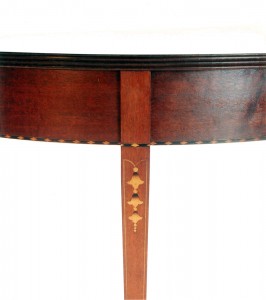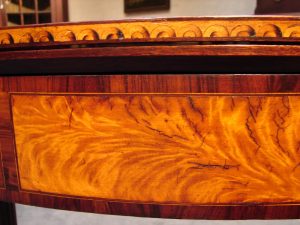We may receive a commission when you use our affiliate links. However, this does not impact our recommendations.
 I’ve studied furniture from the 17th, 18th and early 19th centuries for decades and done my fair share of inlay (the table leg to the left is an example). When the talk around the office this week turned to Rob Millard’s much-anticipated DVD, “Marquetry, Veneer & Inlay for Furniture Makers” (buy your copy here), it brought up memories for me of Woodworking in America conferences past (learn more about WIA here…OK, I’m done huckstering for this post).
I’ve studied furniture from the 17th, 18th and early 19th centuries for decades and done my fair share of inlay (the table leg to the left is an example). When the talk around the office this week turned to Rob Millard’s much-anticipated DVD, “Marquetry, Veneer & Inlay for Furniture Makers” (buy your copy here), it brought up memories for me of Woodworking in America conferences past (learn more about WIA here…OK, I’m done huckstering for this post).
At my first WIA, in Valley Forge, Pa., I put together a Power Point presentation about inlay, stringing and marquetry. I also did demos on how to do those things as well as some sulfur inlay. If you’re unfamiliar with sulfur inlay (sometimes called poor man’s inlay), it’s a process that involves digging out trenches in the wood, smelling up your entire shop and/or house, by melting sulfur (it’s an element) and pouring the liquid into the trench. There’s more to it than that – but not much. Besides, it’s off topic. What I really want to do in this post is toss out a few photos of some old pieces that might just inspire you to learn a little about inlay and banding.
Adding some inlay, stringing or banding to your projects is a fun way to dress them up. It’s also relatively inexpensive unless you get into lots of exotic species. Sure it looks complex (and some of it is in the extreme) but with a few simple tools, techniques and some practice, just about any woodworker can successful.
Most people avoid inlay because they’re afraid they’ll ruin a project they’ve invested tons of time and money into making. Your best bet is to practice on scraps until you’re confident enough to try out the technique on a real project. It sounds simple, but I’ve talked to many woodworkers over the years to whom this idea just never occurred. I mean, you practice dovetailing on scrap first, don’t you?
No matter what level of experience you have, there’s always more to learn. Rob Millard’s work is pretty spectacular and having him here at the Popular Woodworking Magazine studio to film a DVD was both great fun and a tremendous learning experience. Glen D. Huey and I watched pretty intently as Rob filmed a section of the DVD on how to make a Seymour-style lunette banding. The hardest part for both of us was not walking on camera to ask questions.
If I have one word of advice to give to woodworkers, regardless of experience level, it’s don’t be afraid to ask questions. Glen and I both wanted to know why Rob did certain things the way he did. We wanted to know how he overcame certain problems that were inherent to the method he chose. We just had to wait for Ric (the director) to holler “cut!”
p.s. All except the first photo are from period pieces.
Here are some supplies and tools we find essential in our everyday work around the shop. We may receive a commission from sales referred by our links; however, we have carefully selected these products for their usefulness and quality.


















Nice post Chuck. I have tried Sulphur inlay once shortly after I saw you demonstrate it at WIA in 2009. (BTW, here is my recap of that lecture for those interested in some video from the event and my somewhat tiring narration)
What you forgot to tell us during that lecture was how the wife would ban us from ever doing Sulphur inlay again once the smell filtered into the house. Granted in hindsight that seems like common sense 😉
Chuck,
does the DVD cover hand tool techniques? How to make your own tools? What is beyond the edge of the universe?
Jb
Interesting post! I’ve always wanted to attempt some real inlay yet I never actually try to do it. Sulfur is an element?! Who knew? But that video sounds like a good start. I may just have to order it.
Bill
Chuck,
I really like your writings. You write just like you talk. When I read your blog, I can tell it’s you before I see your name at the end. Your a great teacher so keep the blogs coming. Knock yourself out!!
Bill